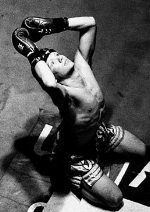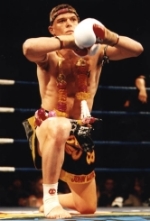Muay Thai History
By Mark Fredebaugh
Dan Rawlings performs a dance traditional in Muay Thai before his fight

John Wayne Parr performs the Wai Khru before a bout.
No one knows the exact time period when Siamese boxing, today known internationally as Muay Thai or Thai boxing, first began. Although tied to Thailand's violent history, the true nature and art of Muay Thai embodies the grace, culture and deeply religious aspects of the sport and fighting style visible today.
Few written records of Muay Thai older than 700 years still exist today, but it is believed to be as old as, or slightly older than some other fighting styles of the "Pacific Rim" countries such as Japan, China and Korea.
Many competitive sports that have achieved popularity today have their origins in ancient martial traditions and training regimes, and Muay Thai is no exception. Muay Thai, in fact, is a direct sport descendant of the fierce weapons system krabi-krabong, a component of which is empty hand fighting.
However, ancient military and political leaders often learned and became experts in such unarmed "martial arts," and in turn taught those forces they commanded in these styles, which is still true of the armed forces soldiers in Thailand today.
The first king that reportedly invested his time and effort into learning the art of Muay Thai, was a king known as Pra chao Sua, who later came to be known as the "Tiger King." As it was punishable by death to touch the king, he had to disguise himself in order to compete in local festivals. 32He repeatedly beat local and national champions, and soon trained his sons in this art as well. Muay Thai soon became known as the "Sport of Kings," and when the Tiger King died, his sons settled their claims to his throne in a Muay Thai bout.
Interest in Muay Thai quickly expanded such that not only did soldiers and royalty continue to train in the art, but also it soon was declared the national sport of Thailand. Yet, the training methods and garb used in matches still was evidence of an ancient culture yet to embrace new technology. During this time period in the continuing development of Muay Thai, the fighters' hands were wrapped in horse hair or thick strands of hemp to both protect the hands, but also to inflict more damage. Also, and only with consent from both sides, the fighters' would spread glue onto their wrapped hands and grind their knuckles into ground glass, sand or small stones.
However, boxing gloves were adopted in the early 1900's, and have become required in many standup competitions today. Another piece of equipment that soon began to see regular use in training and matches was the groin protector. While a kick or knee strike to the groin was a legal attack during this time, protection was still used; mainly in the form of tree bark or a seashell tied with cloth. Soon thereafter, a small triangular pillow was used then abandoned in favor of a "groin box," presently known as a cup.
As the equipment evolved so did the techniques. While allowed in early bouts, head butting and groin attacks were outlawed from regular competitions. While western boxing has become known as "The Sweet Science," Muay Thai has since become known as the "Science of Eight Limbs." The eight weapons of Muay Thai are two hands, two elbows, two knees and two feet.
A typical bout can be three to five rounds long with amateur rounds lasting 2 minutes and professional rounds lasting 3 minutes. While not widely practiced outside of Thailand, both fighters traditionally preform the Wai Khru and Ram Muay before each fight. The Wai Khru is a series of practiced movements through which a fighter shows respect and homage to their nation, family, teacher, opponent and sport while at the same time asking for protection from harm while fighting.
The Wai Khru has deep Buddhist roots and while oft overlooked in many fights abroad, is a serious and spiritual part of many matches. The Ram Muay is another series of movements usually unique to each fighter of training camp. The movements displayed during the Ram Muay often serves to highlight the fighters' specific style of favorite techniques, and some say can help those that bet on the fights to predict the outcome.
Today, Muay Thai is a fast growing sport that is gaining in both media exposure and student following. People of many backgrounds and other martial art disciplines now train in this style of kickboxing. Today, you can see Muay Thai taught as both an effective self-defense strategy and for competition. Today, Muay Thai striking can be seen in events like K - 1, Pride fighting championships and the UFC.
For further information on the history, training camps, clubs and several national and international Muay Thai associations please refer to the links listed in the following section. You may also refer to the glossary page through our website to learn more about specialized terms and techniques.- References:
- The Thai Boxing Association of the USA, 2000
- American TKA Universal Martial Arts, 2001
- The World Muay Thai Council, 2002
- Thai Collectible, "The History of Muay Thai",2003
- The United States Muay Thai Association, 2005








